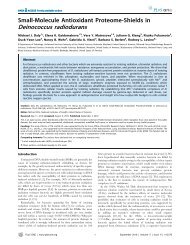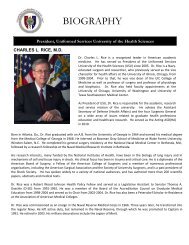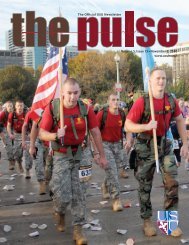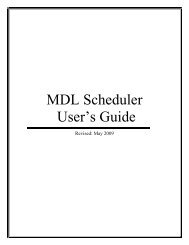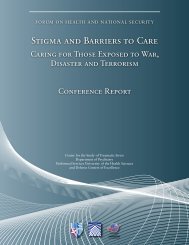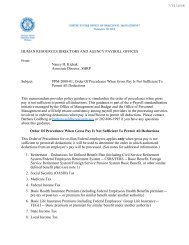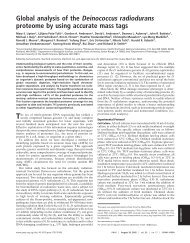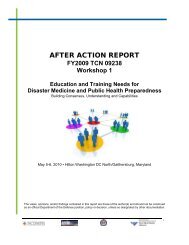Vol. 8, Issue 5 April 15, 2013 - Uniformed Services University of the ...
Vol. 8, Issue 5 April 15, 2013 - Uniformed Services University of the ...
Vol. 8, Issue 5 April 15, 2013 - Uniformed Services University of the ...
Create successful ePaper yourself
Turn your PDF publications into a flip-book with our unique Google optimized e-Paper software.
The Official USU Newsletter<br />
<strong>Vol</strong>ume 8, <strong>Issue</strong> 5 • <strong>April</strong> <strong>15</strong>, <strong>2013</strong><br />
www.usuhs.edu
Sharon Willis<br />
Deputy Vice President for External<br />
Affairs and Managing Editor<br />
Gwendolyn Smalls<br />
Chief, Media Affairs<br />
Tech. Sgt. Oshawn Jefferson<br />
Deputy Chief, Media Affairs<br />
Christine Creenan-Jones<br />
Editor<br />
MC2 Brittney Cannady<br />
Writer<br />
Lori Fields<br />
Layout and Design<br />
The Pulse is printed by USU’s Duplicating Center.<br />
Production<br />
The Pulse is funded by <strong>the</strong> Department <strong>of</strong> Defense and<br />
published by <strong>the</strong> <strong>Uniformed</strong> <strong>Services</strong> <strong>University</strong>. It is<br />
authorized for members <strong>of</strong> <strong>the</strong> U.S. military services,<br />
USU alumni, faculty and staff. Contents <strong>of</strong> <strong>the</strong> Pulse are<br />
not necessarily <strong>the</strong> <strong>of</strong>ficial views <strong>of</strong>, or endorsed by,<br />
<strong>the</strong> DoD or USU. Appearance <strong>of</strong> anything resembling<br />
advertising in this publication does not constitute<br />
endorsement by <strong>the</strong> DoD, USU or Pulse staff members.<br />
The contents <strong>of</strong> this publication shall be made<br />
available for use or patronage without regard to race,<br />
color, religion, sex, national origin, age, marital status,<br />
physical handicap, political affiliation or any o<strong>the</strong>r<br />
non-merit factor <strong>of</strong> <strong>the</strong> user or patron.<br />
Editorial content is edited, prepared and provided by<br />
<strong>the</strong> USU Office <strong>of</strong> External Affairs. The editor reserves<br />
<strong>the</strong> right to edit articles to conform to DoD policy<br />
and Associated Press style. All photos are DoD photos<br />
unless o<strong>the</strong>rwise indicated.<br />
The Pulse will be published bi-weekly on Mondays.<br />
The deadline for submissions is at 4 p.m. Tuesday prior<br />
to <strong>the</strong> publication date. Submissions can be sent to<br />
christine.creenan-jones@usuhs.edu or 301-295-3338.<br />
On <strong>the</strong> cover<br />
Navy Capt. (Dr.) Eric Elster, chair <strong>of</strong> <strong>the</strong><br />
Norman M. Rich Department <strong>of</strong> Surgery at<br />
<strong>the</strong> <strong>Uniformed</strong> <strong>Services</strong> <strong>University</strong>, teaches<br />
second-year medical students different<br />
surgical techniques in <strong>the</strong> Fundamental<br />
Surgical Skills Workshop, one <strong>of</strong> <strong>the</strong> many<br />
opportunities USU students have with <strong>the</strong><br />
department. (See story, page 3.)<br />
Photo by Thomas Balfour<br />
O’Brien honored at scientific symposium<br />
By Christine Creenan-Jones, editor<br />
Alison O’Brien, PhD (center), chair <strong>of</strong> <strong>the</strong> Department <strong>of</strong> Microbiology and Immunology at<br />
<strong>the</strong> <strong>Uniformed</strong> <strong>Services</strong> <strong>University</strong> attended a symposium in her honor along with Samuel<br />
Formal, PhD (left), retired chief <strong>of</strong> <strong>the</strong> Department <strong>of</strong> Bacterial Diseases at <strong>the</strong> Walter Reed<br />
Army Institute <strong>of</strong> Research, and Larry Laughlin, MD, PhD (right), dean emeritus <strong>of</strong> USU’s<br />
School <strong>of</strong> Medicine. The event highlighted O’Brien’s groundbreaking Shiga toxin research<br />
over <strong>the</strong> past 30 years.<br />
The <strong>Uniformed</strong> <strong>Services</strong> <strong>University</strong><br />
recognized Alison O’Brien, PhD,<br />
pr<strong>of</strong>essor and chair <strong>of</strong> <strong>the</strong> university’s<br />
Department <strong>of</strong> Microbiology<br />
and Immunology, by co-sponsoring a<br />
symposium in her honor, March 29.<br />
The event, held in Sanford Auditorium,<br />
included plenary talks and<br />
presentations that chronicled O’Brien’s<br />
groundbreaking work over <strong>the</strong> past<br />
30 years. Guest speakers described<br />
O’Brien’s most important scientific<br />
accomplishments and <strong>the</strong> discoveries<br />
<strong>the</strong>y catalyzed.<br />
O’Brien, who is best known for her<br />
pioneering Shiga toxin research, first<br />
made headlines in <strong>the</strong> early 1980s,<br />
when she published a landmark letter<br />
in a leading medical journal that linked<br />
<strong>the</strong> production <strong>of</strong> Shiga toxin with E.<br />
coli strains and foodborne illness.<br />
Since <strong>the</strong>n, her lab has yielded<br />
many new discoveries, including<br />
producing <strong>the</strong> first set <strong>of</strong> monoclonal<br />
antibodies that neutralize different<br />
types <strong>of</strong> Shiga toxin. Fur<strong>the</strong>rmore,<br />
O’Brien collaborated with a pharmaceutical<br />
company to develop and test<br />
humanized antibodies for treatment<br />
<strong>of</strong> diseases caused by Shiga toxinproducing<br />
E. coli.<br />
In addition to her scientific<br />
achievements, O’Brien was also<br />
lauded for <strong>the</strong> contributions she’s<br />
made on campus. Larry Laughlin,<br />
MD, PhD, dean emeritus <strong>of</strong> USU’s<br />
School <strong>of</strong> Medicine, recounted several<br />
in his welcome address.<br />
“I remember being part <strong>of</strong> <strong>the</strong> faculty<br />
that interviewed Alison to be chair <strong>of</strong><br />
her department,” he said. “I recognized<br />
immediately she was a fierce person and<br />
<strong>the</strong> right choice for <strong>the</strong> job.”<br />
Laughlin also commended O’Brien<br />
for being a “strong leader,” “incredible<br />
scholar,” “honorable person” and<br />
for running one <strong>of</strong> USU’s most effective<br />
departments.<br />
Courtesy Photo<br />
2 The Pulse The Official USU Newsletter
Top military medical leaders, new doctors meet at<br />
USU Surgical Associates Day<br />
By Daniel Henry, writer for Health.mil<br />
Photo by Daniel Henry, MHS Strategic Communications<br />
Dr. David Welling, associate pr<strong>of</strong>essor in <strong>the</strong><br />
Department <strong>of</strong> Surgery at <strong>the</strong> <strong>Uniformed</strong><br />
<strong>Services</strong> <strong>University</strong>, presents <strong>the</strong> Jean<br />
Dominique Larrey Award to Navy Capt. (Dr.)<br />
Eric Elster, chair <strong>of</strong> <strong>the</strong> Department <strong>of</strong> Surgery<br />
at USU, for outstanding contributions to<br />
surgery. The award was presented during<br />
this year’s USU Surgical Associates Day.<br />
Dr. Jonathan Woodson, assistant<br />
secretary <strong>of</strong> defense for Health<br />
Affairs, joined scholars, physicians,<br />
residents and future military medical<br />
<strong>of</strong>ficers for <strong>the</strong> <strong>Uniformed</strong> <strong>Services</strong><br />
<strong>University</strong>’s annual Surgical Associates<br />
Day, March 28.<br />
Since 1981, USU Surgical Associates<br />
Day has brought USU students<br />
toge<strong>the</strong>r with leaders for mentorship<br />
and exposure to best practices.<br />
Woodson, a vascular surgeon who<br />
has worked in <strong>the</strong> civilian, academic<br />
and military m edical communities,<br />
highlighted <strong>the</strong> long and impressive<br />
partnership between civilian and<br />
military medicine. “Military medicine<br />
has much to be proud <strong>of</strong>,” Woodson said.<br />
“We have a history <strong>of</strong> making advances<br />
that have been adopted into <strong>the</strong> public<br />
sector. The Joint Trauma System [for<br />
instance] has led to <strong>the</strong> highest survival<br />
rate in recorded warfare.”<br />
Woodson said <strong>the</strong>se and o<strong>the</strong>r<br />
advances, which were forged in<br />
combat, will continue to transform<br />
peacetime civilian medicine.<br />
Navy Capt. (Dr.) Eric Elster, pr<strong>of</strong>essor<br />
and chairman <strong>of</strong> USU’s Norman M.<br />
Rich Department <strong>of</strong> Surgery, said USU<br />
Surgical Associates Day gives students<br />
and young physicians <strong>the</strong> opportunity to<br />
interact with <strong>the</strong> best in <strong>the</strong>ir pr<strong>of</strong>ession.<br />
“Both <strong>the</strong> students and <strong>the</strong> residents<br />
represent <strong>the</strong> future <strong>of</strong> military<br />
medicine and academic surgery. Exposing<br />
<strong>the</strong>m to leadership in medicine is a<br />
smart investment,” Elster said.<br />
O<strong>the</strong>r medical leaders at <strong>the</strong> event<br />
included Dr. Michael F. Rotondo, chair<br />
<strong>of</strong> <strong>the</strong> committee on trauma, at <strong>the</strong><br />
American College <strong>of</strong> Surgeons and Dr.<br />
David B. Hoyt, ACS executive director.<br />
In addition to hearing from top<br />
medical leaders, surgical residents<br />
presented <strong>the</strong>ir own research<br />
conducted over <strong>the</strong> course <strong>of</strong> a year.<br />
“Each <strong>of</strong> <strong>the</strong>se residents presented<br />
that body <strong>of</strong> work on areas ranging<br />
from advanced imaging <strong>of</strong> limb<br />
ischemia, development <strong>of</strong> novel strategies<br />
to improve outcome after shock,<br />
wound closure methods in casualties<br />
and treatment <strong>of</strong> pediatric tumors with<br />
non-invasive <strong>the</strong>rapy,” Elster said.<br />
He added, “Our visiting pr<strong>of</strong>essors,<br />
doctors Hoyt and Rotondo, were<br />
extremely impressed, not only with <strong>the</strong><br />
quality <strong>of</strong> <strong>the</strong> science involved, but also<br />
<strong>the</strong> ability <strong>of</strong> <strong>the</strong> residents to understand<br />
and articulate <strong>the</strong> scope <strong>of</strong> <strong>the</strong> work.”<br />
Woodson said student participants<br />
are, “part <strong>of</strong> a great legacy and<br />
master <strong>of</strong> <strong>the</strong> future <strong>of</strong> <strong>the</strong> military<br />
health system.” He added, “Nothing<br />
can compare to <strong>the</strong> military health<br />
system…The future is bright and <strong>the</strong>y<br />
have dynamic careers and opportunities<br />
ahead <strong>of</strong> <strong>the</strong>m. For us, <strong>2013</strong> is<br />
a transformative year and it is very<br />
important for our leaders to make<br />
<strong>the</strong>m understand that as seniors we are<br />
invested in our junior <strong>of</strong>ficers. We have<br />
to spend time with <strong>the</strong>m…in contact.<br />
That’s how <strong>the</strong>y will stay motivated.”<br />
Photo by Erin Perez, SRMC Public Affairs, U.S. Army Sou<strong>the</strong>rn Regional Medical Command<br />
USU Excellence in Teaching Award<br />
Dr. Charles Rice, president <strong>of</strong> <strong>the</strong> <strong>Uniformed</strong> <strong>Services</strong><br />
<strong>University</strong>, presents <strong>the</strong> university's Excellence in Teaching<br />
Award to Army Maj. Gen. M. Ted Wong, commanding<br />
general <strong>of</strong> <strong>the</strong> Sou<strong>the</strong>rn Regional Medical Command,<br />
<strong>April</strong> 5. The prestigious award is accompanied by a<br />
grant from <strong>the</strong> Henry M. Jackson Foundation, and was<br />
presented to <strong>the</strong> San Antonio Military Health System<br />
(SAMHS), to benefit both San Antonio Military Medical<br />
Center and Wilford Hall Ambulatory Surgical Center.<br />
Pictured in <strong>the</strong> photo from left to right are Army Col. Kyle<br />
Campbell, commander, Brooke Army Medical Center;<br />
Wong; Rice; Air Force Col. Randall Zernzach, associate<br />
dean, San Antonio <strong>Uniformed</strong> <strong>Services</strong> Health Education<br />
Consortium (Texas); retired Maj. Gen. Patrick Sculley,<br />
senior vice president, <strong>University</strong> Programs, USU; and Air<br />
Force Col. James McClain, SAMHS.<br />
<strong>April</strong> <strong>15</strong>, <strong>2013</strong> 3
Former deputy nursing chief joins<br />
USU faculty<br />
By Christine Creenan-Jones, editor<br />
Navy Rear Adm. (ret.) Cynthia Dullea<br />
As a young girl, Cindy Dullea,<br />
a distinguished pr<strong>of</strong>essor in <strong>the</strong><br />
Graduate School <strong>of</strong> Nursing at <strong>the</strong><br />
<strong>Uniformed</strong> <strong>Services</strong> <strong>University</strong>, spent<br />
countless hours talking to nurses at<br />
Massachusetts General Hospital in<br />
Boston. For six months, <strong>the</strong>y took<br />
care <strong>of</strong> her favorite grandmo<strong>the</strong>r, who<br />
was burned in a terrible accident.<br />
Dullea suffered with her grandmo<strong>the</strong>r<br />
as she endured painful skin<br />
grafts and multiple surgeries, but <strong>the</strong><br />
high school freshman found solace<br />
at <strong>the</strong> nurses’ station, where skill and<br />
compassion resided.<br />
Inspired by <strong>the</strong>ir healing hands,<br />
Dullea decided to follow in <strong>the</strong>ir<br />
footsteps and pursue a career in<br />
nursing. She attended college at Salve<br />
Regina <strong>University</strong> in Newport, R.I., a<br />
city beaming with Navy pride. After<br />
earning her degree, Dullea began<br />
working as a staff nurse at The Medical<br />
<strong>University</strong> <strong>of</strong> South Carolina on <strong>the</strong><br />
critical care ward. Even though she’d<br />
fulfilled one dream, Dullea was restless.<br />
“Back <strong>the</strong>n, I was a brazen 23-year<br />
old, ready for some excitement,” she<br />
said. “My boyfriend, who is now my<br />
husband, encouraged me to consider<br />
<strong>the</strong> military, so I called a Navy<br />
recruiter. The rest is history.”<br />
Once she commissioned, Dullea<br />
left South Carolina to embark on a<br />
Photo by Thomas Balfour<br />
whirlwind military career that brought<br />
her to several major coastal cities in<br />
<strong>the</strong> United States and duty stations<br />
overseas. She spent nearly 30 years in<br />
<strong>the</strong> Navy Nurse Corps, between activeduty<br />
and reserve service.<br />
Dullea excelled at each post and<br />
quickly rose through <strong>the</strong> ranks,<br />
commanding five different units.<br />
By <strong>the</strong> time she retired, Dullea was<br />
one <strong>of</strong> only nine medical reserve<br />
admirals, and served as both deputy<br />
commander <strong>of</strong> Navy Medicine<br />
National Capital Area and deputy<br />
director <strong>of</strong> <strong>the</strong> Navy Nurse Corps.<br />
Throughout her impressive military<br />
career, Dullea had many opportunities<br />
to work with service members from<br />
every branch <strong>of</strong> service. They became<br />
her new inspiration.<br />
“Since I spent a good part <strong>of</strong> my<br />
career in <strong>the</strong> reserves, I was able to<br />
experience military and civilian ways <strong>of</strong><br />
life,” she said. “I can say with unequivocal<br />
certainty, <strong>the</strong>re is nothing more<br />
rewarding than uniformed service. As a<br />
naval <strong>of</strong>ficer, I worked with people who<br />
had a unique moral fiber to <strong>the</strong>m. They<br />
aren’t motivated by pr<strong>of</strong>it, just achieving<br />
<strong>the</strong> mission. They’re an incredible,<br />
selfless group, and it was a great honor<br />
to serve with <strong>the</strong>m for so many years.”<br />
At USU, Dullea’s passion continues<br />
to burn strong. She teaches two<br />
graduate-level nursing courses that<br />
cover leadership and health informatics,<br />
topics that drove both her military<br />
and civilian careers into high gear.<br />
“Besides serving in <strong>the</strong> reserves, I<br />
also helped start a health informatics<br />
company and worked in <strong>the</strong> field for<br />
more than 20 years. My two working<br />
worlds were very different in many<br />
respects, but <strong>the</strong>y also brought value<br />
to each o<strong>the</strong>r. Realizing this, I tried to<br />
incorporate <strong>the</strong> strong points <strong>of</strong> military<br />
medicine into my private practice and<br />
vice versa,” Dullea said. “At USU, I want<br />
my students to think outside <strong>of</strong> <strong>the</strong> box,<br />
as well. A broad, creative vision is <strong>the</strong><br />
best impetus for progress and change.”<br />
Countdown to<br />
Commencement<br />
Trivia Question<br />
Commencement at <strong>the</strong><br />
<strong>Uniformed</strong> <strong>Services</strong> <strong>University</strong><br />
is full <strong>of</strong> many time-honored<br />
traditions that make it a truly<br />
spectacular event. Among <strong>the</strong>m,<br />
<strong>the</strong> Marine Corps Band plays<br />
Pomp and Circumstance as USU<br />
students march down <strong>the</strong> processional<br />
wearing academic regalia<br />
over <strong>the</strong>ir service dress uniforms.<br />
They’re led by faculty and this<br />
mace-bearing person, who is given<br />
<strong>the</strong> honor for a job well done.<br />
Do you know who carries <strong>the</strong><br />
mace at USU’s commencement<br />
each year? If so, e-mail your<br />
response to Christine.Creenan-<br />
Jones@usuhs.edu for a chance to<br />
win a free large c<strong>of</strong>fee and doughnut,<br />
courtesy <strong>of</strong> USU’s cafeteria.<br />
Twitter<br />
Follow us at<br />
https://twitter.com/<br />
usuhspao<br />
Photo by Thomas Balfour<br />
4 The Pulse The Official USU Newsletter
Frontline experience inspires <strong>of</strong>ficer to choose<br />
military medicine<br />
By Christine Creenan-Jones, editor<br />
Army 2nd Lt. Braden Hestermann (second from left) is a fourth-year medical student at <strong>the</strong> <strong>Uniformed</strong> <strong>Services</strong> <strong>University</strong>. Before he arrived on<br />
campus, Hestermann was a medical platoon leader in Iraq and served alongside many servicemembers, including Sgt. 1st Class Ben Sebban (far<br />
left), who was killed by a roadside bomb, Sgt. John Gilbert (third from left) and Sgt. Tony Trout (right).<br />
Courtesy Photo<br />
Army 2nd Lt. Braden Hestermann,<br />
a fourth-year medical student at <strong>the</strong><br />
<strong>Uniformed</strong> <strong>Services</strong> <strong>University</strong>, has<br />
seen a lot in his short military career.<br />
After graduating from West Point in<br />
2004, he spent <strong>15</strong> long months on Iraq’s<br />
brutal frontlines.<br />
While <strong>the</strong>re, Hestermann came<br />
face-to-face with war’s most dire<br />
consequences. In 2007, he was a<br />
medical platoon leader working<br />
in Diyala, a dangerous province<br />
controlled by Sunni insurgents. Fighting<br />
was fierce in Diyala, and many<br />
servicemembers were badly wounded<br />
or killed in battle.<br />
Hestermann helped as much as<br />
he could by calling MEDEVACs and<br />
coordinating patient evacuations<br />
to major military hospitals, but he<br />
still felt powerless as colleagues and<br />
friends around him grappled with<br />
life-changing injuries.<br />
“I wanted to help so badly, but all I<br />
could do was call an Evac, watch and<br />
wait,” he said. “It was a terrible feeling.”<br />
By <strong>the</strong> end <strong>of</strong> his tour, Hestermann<br />
was ready for a new career path. He<br />
wanted to be a military doctor, so he<br />
could take care <strong>of</strong> wounded servicemembers<br />
like <strong>the</strong> ones he’d served<br />
with in Iraq.<br />
“USU was a no-brainer for me,”<br />
Hestermann said. “I wanted to stay in<br />
<strong>the</strong> Army, and USU gives you a better<br />
exposure to military medicine than any<br />
o<strong>the</strong>r medical school around.”<br />
On course to graduate in May,<br />
Hestermann will move to San<br />
Antonio by <strong>the</strong> end <strong>of</strong> <strong>the</strong> summer,<br />
where he’ll begin his residency in<br />
anes<strong>the</strong>siology at Brooke Army<br />
Medical Center.<br />
“Anes<strong>the</strong>siology is a great fit for<br />
me,” he said. “It’s a hands-on discipline.<br />
Plus, I like to know that what<br />
I’m doing is helping, and in this field,<br />
you get immediate feedback.”<br />
Hestermann’s excitement for his<br />
future is tempered only by <strong>the</strong> memories<br />
he’s created at USU. He’s president <strong>of</strong><br />
a tight-knit class that has bonded over<br />
<strong>the</strong>ir tough classes, military training,<br />
field exercises and rotations.<br />
“I’ve had such a great experience<br />
here,” Hestermann said. “The<br />
camaraderie at USU is incredible,<br />
because we are all working toward<br />
<strong>the</strong> same goal. I’ll hold onto <strong>the</strong>se<br />
experiences forever.”<br />
<strong>April</strong> <strong>15</strong>, <strong>2013</strong> 5
Word on Campus<br />
By Christine Creenan-Jones, editor<br />
Spring is finally in <strong>the</strong> air, so Pulse staff members wanted<br />
to know how personnel at <strong>the</strong> <strong>Uniformed</strong> <strong>Services</strong> <strong>University</strong><br />
plan to enjoy <strong>the</strong> warmer wea<strong>the</strong>r. Here are some <strong>of</strong><br />
<strong>the</strong>ir answers:<br />
“I’m potty training my<br />
son during spring break.<br />
We’ll both be home, so<br />
I’ll be able to give him<br />
a lot more one-on-one<br />
attention. I hope it sticks.”<br />
Army 2nd Lt. Tim Hunter, 1st-year medical student<br />
“I love to garden, so<br />
springtime is a great time<br />
to be outside enjoying <strong>the</strong><br />
warmer wea<strong>the</strong>r.”<br />
Denise Anderson,<br />
admissions <strong>of</strong>ficer<br />
“Spring has sprung, and<br />
I’m looking forward to <strong>the</strong><br />
extended daylight, moonlight<br />
gardening, biking, hiking,<br />
attempting to get in shape.”<br />
as possible.”<br />
“I’m a Floridian, so we have<br />
spring and summer wea<strong>the</strong>r<br />
year round. I’ve missed it<br />
living here, so when it finally<br />
warms up, I plan to get out<br />
and enjoy <strong>the</strong> sites as much<br />
Andrew Lee, contract specialist<br />
“I’m going to fly kites with<br />
my daughter.”<br />
Navy Lt. Brian Andrews-Shigaki,<br />
assistant pr<strong>of</strong>essor, Department <strong>of</strong><br />
Military and Emergency Medicine<br />
Navy Petty Officer 3rd Class Juanita Lane,<br />
information technology specialist<br />
HPRC Health Tips<br />
USU’s Human Performance<br />
Resource Center Health Tips are<br />
intended to provide <strong>the</strong> USU<br />
community with information to<br />
help develop and maintain a healthy<br />
lifestyle. Check out <strong>the</strong> HPRC<br />
website at: http://hprc-online.org.<br />
Photo by Thomas C. Balfour<br />
Add some water to your workout<br />
Swimming and o<strong>the</strong>r water workouts<br />
are great ways to give aching joints a<br />
break or recover from an injury and<br />
still get in a good workout. Exercising<br />
in <strong>the</strong> water provides <strong>the</strong> same<br />
aerobic fitness benefits as exercising on<br />
land. In fact, exercising in water may<br />
be less work for your heart, because it<br />
pumps out more blood per beat, and<br />
heart rates are slightly slower. What’s<br />
more, pressure from <strong>the</strong> water speeds<br />
blood flow back to your heart, where<br />
your blood gets <strong>the</strong> oxygen that your<br />
muscles need during exercise.<br />
Aquatic exercise is great for most people,<br />
including older and younger folks.<br />
Effective pool training sessions<br />
should vary in intensity and<br />
emphasis. To avoid shoulder joint<br />
and upper back issues, warm<br />
up by swimming for five to ten<br />
minutes at a pace slower than your<br />
usual training pace, and include<br />
kicking and pulling drills. To<br />
improve both strength and endurance<br />
in <strong>the</strong> water, try interval<br />
training. Shorter rest intervals will<br />
improve endurance, while longer<br />
ones will stress your anaerobic<br />
system and improve your strength<br />
and power. Alternating between<br />
aerobic (longer and slower) and<br />
anaerobic (shorter and more<br />
intense) workouts will optimize<br />
your overall performance for both<br />
combat swimming operations and<br />
cardiovascular fitness in general.<br />
Information provided by HPRC.<br />
6 The Pulse The Official USU Newsletter
School <strong>of</strong> Medicine celebrates exceptional educators<br />
By Air Force Col. (Dr.) Arnyce Pock, director, Office <strong>of</strong> Curriculum Reform<br />
Larry Laughlin, PhD, MD, dean<br />
emeritus at <strong>the</strong> <strong>Uniformed</strong> <strong>Services</strong><br />
<strong>University</strong>’s School <strong>of</strong> Medicine,<br />
recognized several outstanding<br />
faculty members who’ve made<br />
Photo by Army Spc. Ernest Sivia<br />
significant contributions to <strong>the</strong> new<br />
“Molecules to Military Medicine”<br />
curriculum. Laughlin personally<br />
thanked 44 educators, all <strong>of</strong> whom<br />
were nominated by <strong>the</strong> chairperson<br />
<strong>of</strong> <strong>the</strong>ir respective department, in a<br />
ceremony held in <strong>the</strong> Small Dining<br />
Room, March 22.<br />
During <strong>the</strong> ceremony, <strong>the</strong> Curriculum<br />
Reform Team also thanked<br />
Laughlin for his leadership and<br />
support. Besides words <strong>of</strong> praise,<br />
<strong>the</strong>y presented him with a custom<br />
piece <strong>of</strong> art that commemorated <strong>the</strong><br />
launch <strong>of</strong> a new curriculum that<br />
completely transformed <strong>the</strong> way<br />
medical students learn at USU.<br />
Dan Balog, MD<br />
Suzanne Bausch, PhD<br />
Anthony Beutler, MD<br />
Diane Borst, PhD<br />
Chris Broder, PhD<br />
Meir Chern<strong>of</strong>sky, MD<br />
Richard Conran, MD<br />
Annesley Copeland, MD<br />
Tom Cote, PhD<br />
Gary Crouch, MD<br />
Cathy Decker, MD<br />
Saibal Dey, PhD<br />
Steve Durning, MD<br />
Matt Eberly, MD<br />
Craig Goolsby, MD<br />
David Grahame, PhD<br />
Neil Grunberg, PhD<br />
Derrick Hamaoka, MD<br />
Kris Heitman, PhD<br />
Bill Kelly, MD<br />
Barbara Knollmann-Ritschel, MD<br />
Jeff LaRochelle, MD<br />
Then and now: <strong>University</strong> Archives captures university history<br />
with online repository<br />
By MC2 Brittney Cannady, writer, and Christine Creenan-Jones, editor<br />
Grant Lattin, MD<br />
Eric Marks, MD<br />
David Mears, PhD<br />
Scotty Merrell, PhD<br />
Jon Meyerle, MD<br />
Ed Mitre, MD<br />
Brian Neubauer, MD<br />
Cara Olsen, PhD<br />
Pat O’Malley, MD<br />
Tim O’Neil, PhD<br />
James Palma, MD<br />
Lee Poth, MD<br />
Anthony Propst, MD<br />
Mark Roseman, PhD<br />
Steve Rothwell, PhD<br />
Doug Rose, MD<br />
Jessica Servey, MD<br />
Al Seyfer, MD<br />
Alice Smith, MD<br />
Louise Teel, PhD<br />
Terrill Tops, MD<br />
Justin Woodson, MD<br />
At <strong>the</strong> <strong>Uniformed</strong> <strong>Services</strong> <strong>University</strong>,<br />
people keep <strong>the</strong>ir finger on <strong>the</strong><br />
pulse by reading <strong>the</strong> Pulse. It’s filled<br />
with important university news and<br />
candid feature articles.<br />
The Pulse hasn’t been USU’s only<br />
publication. Earlier archetypes preceded<br />
it, like <strong>the</strong> Vector, FYI and USUHS<br />
Quarterly. These products captured<br />
important aspects <strong>of</strong> USU’s history,<br />
beginning in 1978 when <strong>the</strong> Vector,<br />
<strong>the</strong> oldest campus publication, was first<br />
created by <strong>the</strong> charter class.<br />
In an effort to preserve a unique part<br />
<strong>of</strong> USU’s history, <strong>the</strong> <strong>University</strong> Archives<br />
department has created an online repository<br />
for campus publications.<br />
“We’ve collected publications piecemeal<br />
over <strong>the</strong> years, so we don’t have<br />
a complete run <strong>of</strong> any <strong>of</strong> <strong>the</strong>m,” said<br />
Emelie Rubin, USU’s institutional archivist.<br />
“If anyone at <strong>the</strong> university would<br />
like to donate <strong>the</strong>ir back issues to <strong>the</strong><br />
archives, we will gladly scan and add<br />
<strong>the</strong>m to our collection.”<br />
The repository may be a work in<br />
progress, but it already has hundreds <strong>of</strong><br />
different artifacts to browse, which illustrate<br />
<strong>the</strong> life – and sometimes humor –<br />
behind USU.<br />
“The Vector tended to be light in<br />
tone and usually had humorous articles<br />
and cartoons drawn by students,” said<br />
Rubin. “The Vector from <strong>April</strong> 1, 1988 is<br />
an excellent example <strong>of</strong> <strong>the</strong> tongue-incheek<br />
nature <strong>of</strong> <strong>the</strong> publication. For this<br />
<strong>April</strong> Fool’s Day issue, <strong>the</strong> publication<br />
was renamed The Infector and it poked<br />
fun at some <strong>of</strong> <strong>the</strong> faculty members. It<br />
showed how, even though <strong>the</strong> students<br />
were going through rigorous training,<br />
<strong>the</strong>y were still able to have some fun.”<br />
The different generations <strong>of</strong> publications<br />
also capture USU’s growth over<br />
<strong>the</strong> years. Early print publications were<br />
more basic than today’s Pulse with<br />
barebones design elements.<br />
“It is interesting to see that as<br />
technology improves and <strong>the</strong> university<br />
becomes more mature, how our<br />
publications improve in quality. Early<br />
students published The Vector using<br />
typewriters and <strong>the</strong>n early word<br />
processing s<strong>of</strong>tware,” said Rubin. “In<br />
later publications, like <strong>the</strong> USUHS<br />
Quarterly, <strong>the</strong> university printed <strong>the</strong>m<br />
in full color and included photographs.<br />
The rudimentary nature <strong>of</strong> The<br />
Vector reflects <strong>the</strong> nascent roots <strong>of</strong> <strong>the</strong><br />
<strong>University</strong>.”<br />
<strong>University</strong> Archives has salvaged<br />
many <strong>of</strong> <strong>the</strong>m – from early, more simple<br />
publications to USU’s modern, pr<strong>of</strong>essionally<br />
created newsletters, and <strong>the</strong>y<br />
are available to view online at http://<br />
www.lrc.usuhs.edu/archives/.<br />
<strong>April</strong> <strong>15</strong>, <strong>2013</strong> 7
Final Frame<br />
Photo by Thomas C. Balfour<br />
The Department <strong>of</strong> Preventive Medicine invited animal handler, Bruce<br />
Shwedick, to <strong>the</strong> <strong>Uniformed</strong> <strong>Services</strong> <strong>University</strong> for <strong>the</strong> annual Snakes Alive!<br />
program, <strong>April</strong> 3. Shwedick is a snake expert, who shared information about<br />
snake wounds. This unique aspect <strong>of</strong> health care is important because<br />
USU graduates may practice medicine in desert or tropical locations where<br />
reptiles like rattlesnakes, anacondas or cobras thrive, and must be able to<br />
recognize and treat bites and o<strong>the</strong>r injuries suffered by military members or<br />
<strong>the</strong>ir families as a result <strong>of</strong> an encounter with one.



